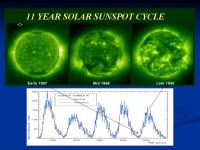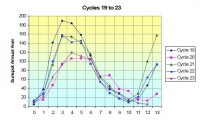By Joseph D’Aleo, CCM
In 1610, shortly after viewing the sun with his new telescope, Galileo Galilei made the first European observations of Sunspots. Daily observations were started at the Zurich Observatory in 1749 and with the addition of other observatories continuous observations were obtained starting in 1849. As a climatologist, I always found it amazing that we have had regular sunspot data far longer than we have had reliable coverage of temperature or precipitation.
Monthly averages (updated monthly) of the sunspot numbers show that the number of sunspots visible on the sun waxes and wanes with an approximate 11-year cycle, The last five cycles are shown in the diagram below.

See larger image here
You can see from this diagram that the cycles are not equal in magnitude (smoothed sunpot number peaked 110 to 200) or period (9.8 to 12+ years). If you superimpose the five cycles you can see this even more dramatically. The chart has the annual average sunspot number and starts with the year of the solar minimum (lowest sunspot average). You can see that cycles 19, 21, and 22 were higher amplitude and shorter periods (bottoming out in years 9-10 and then rebounding rapidly). Cycles 20 and 23 were less amplified and longer. Cycle 20 lasted about 11.8 years. It appears from the evidence we will present that cycle 23 has not yet bottomed out and thus is at least 12 years long.

See larger image here
See in this analysis how longer, quieter cycles correlate with global cooling and shorter, stronger cycles with warming. The current cycle 23 appears to be the longest in at least a century and may project to quieter subsequent cycles and cooling temperatures ahead.




